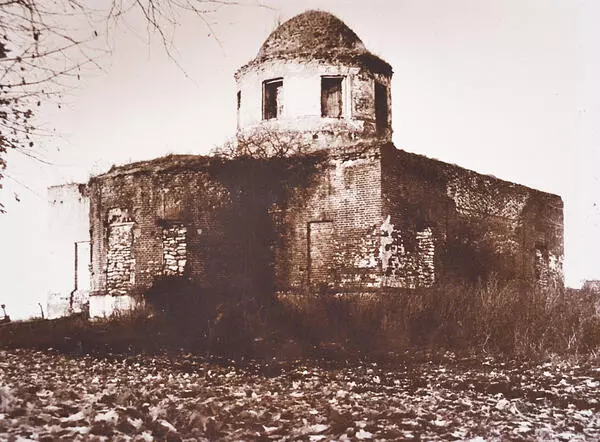ZlObino is a village which was located in the YelEtsky District of OrYOl Governorate (now it is the StanovlYAnsky District of LIpetsk Region) According to historians, it dates back to the beginning of 18 century. Located on the high banks of the small river VorgOl, about 7 miles away from the railway station StanovOe, it was located not far from the Bunins estate. Many Bunins, including Bunin’s young brothers and sister, were christened, married, and read the funeral service in the local church. They were also buried at the local cemetery. Ivan Bunin’s father, AlexEy NikolAevich, was also christened here, here he married LyudmIla AlexAndrovna ChubArova. The church was built with the blessing of St. Tikhon, the bishop of VorOnezh, and was consecrated on November 12, 1766. The first church existed until 1872 and was abolished by the decision of the eparchy authorities. In the same year, 1872, the altar of the new brick church in the name of the prophet Elijah was consecrated, and in 1883 the main part of the church with the throne in the name of the Intercession of the Godmother was completed.
In 1886, two more side altars were consecrated, and in 1895 the parishioners paid for building a fence of hewn stone, covered with iron around the church. A beautiful church, standing on a hill, could be seen from afar, and a cemetery was located nearby. Bunin’s aunt, VarvAra NikolAevna, died in KAmenka in 1905. She was buried at the cemetery in the village of ZlObino. In his story “Dry valley” Bunin mentioned the family cemetery and the church, but he changed the name of the village and called it CherkIzovo. After the Great October Revolution of 1917, the PokrOvsky Church shared the sad fate of most churches in Russia. In 1922 about 1 kilogram of valuable precious metals was appropriated from the church. In 1929 only 65 persons were parishioners of this church. According to eyewitnesses, the church was functional until 1931-1933. Before the World War II the church was closed and out of use. After the war was finished, it was used as a warehouse. Then the church building was used for placing the repair shops. Later a warehouse with fertilizers was organized there. The building was gradually demolished: the windows were broken, doors and gates were removed. The domes were demolished in 1941… Since 2011, the villagers began to gradually restore the ruined church. Currently the church services are held there on holidays.
Presumably, it was this church Bunin wrote about in his poem:
In 1886, two more side altars were consecrated, and in 1895 the parishioners paid for building a fence of hewn stone, covered with iron around the church. A beautiful church, standing on a hill, could be seen from afar, and a cemetery was located nearby. Bunin’s aunt, VarvAra NikolAevna, died in KAmenka in 1905. She was buried at the cemetery in the village of ZlObino. In his story “Dry valley” Bunin mentioned the family cemetery and the church, but he changed the name of the village and called it CherkIzovo. After the Great October Revolution of 1917, the PokrOvsky Church shared the sad fate of most churches in Russia. In 1922 about 1 kilogram of valuable precious metals was appropriated from the church. In 1929 only 65 persons were parishioners of this church. According to eyewitnesses, the church was functional until 1931-1933. Before the World War II the church was closed and out of use. After the war was finished, it was used as a warehouse. Then the church building was used for placing the repair shops. Later a warehouse with fertilizers was organized there. The building was gradually demolished: the windows were broken, doors and gates were removed. The domes were demolished in 1941… Since 2011, the villagers began to gradually restore the ruined church. Currently the church services are held there on holidays.
Presumably, it was this church Bunin wrote about in his poem:
New church
The spring wind was dancing
Among the white and empty walls
And white droplets of paint
Falling from somewhere upstairs
Onto the golden iconostasis
The sonorous roar between the church pillars Among and in-between the scaffolds
Wearing robes we walked
with our paints and brushes towards the heaven
And often, together with the house painters
We sang our chants out there And Jesus Christ whom we painted
On the walls of this joyful temple
To glorify
It seemed to us that our chants
Will make him recall
His home in Nazareth, and the sun shining around
His work bench and blue chiton




